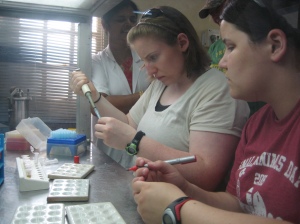The FSF India students have passed the 1/2 way point of their stay in India and are fully embedded in a variety of different projects. Despite many challenges that coming with living in a radically different culture, they are enthusiastic and take all challenges head on.
The students are embedded into three projects. The first project revolves around establishing the prevalence of brucellosis in cattle in Tamil Nadu. They are helping researchers sample various populations of cows and then running various brucellosis screening tests to establish prevalence rates. Brucellosis is not something that we see at all in the US (eradicated accept in Buffalo and Elk around Yellowstone National Park).
The second project is aimed at
establishing the presence of BVDV in Tamil Nadu. Officially, the presence of BVDV in India is not recognized. So little is known about prevalence of what isolates of virus are present in India and specifically Tamil Nadu. So similar to the Brucellosis project, students are collecting blood and milk samples from various cow populations to establish prevalence rates and to identify actual virus isolates.
The final project involves supplementing the diets of dairy cows that are fed waste material from cooking rice. In brief, in the agriculture villages, the primary diet of humans is rice. When rice is cooked, the water that is strained off of the cooked rice, or gruel, is commonly fed to cows. The idea is that if key minerals and non-protein nitrogen are added to this gruel, milk production will increase. So students have enrolled ~60 farms to add a custom made mineral/urea mix to gruel over the next 30 days during which milk production will be monitored. Her is the kicker. The mineral/urea mix will cost roughly 1/5 of a penny per day and is expected to increase milk production by about 300 ml per day. An extra 300 ml will increase revenue to the farmer by ~$0.25. So a 1:125 pay-off!! Not bad. Oh and by the way, $0.25, which is roughly 15 Rupees, is a lot of money to a village farmer.



